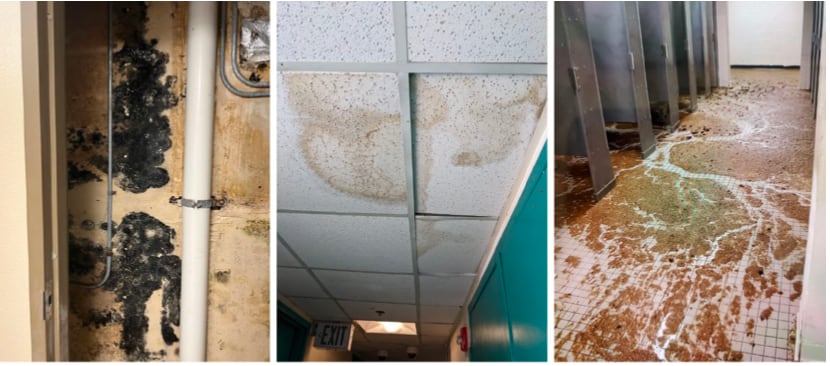No one has been fired over mold and other “disgusting” conditions in military barracks, the Pentagon’s top installations official told lawmakers Wednesday. Now members of Congress are questioning whether that lack of accountability has become a major hurdle to fixing those problems for good.
Members of the House Armed Services Committee’s readiness panel pressed Brendan Owens, the assistant secretary of defense for energy, installations and environment, for more oversight and accountability of barracks at a hearing Feb. 7.
“No one from [Defense Secretary Lloyd Austin] down to your level, down to the services, down to the base commander … nobody has actually been held accountable, correct? No one’s actually been relieved or fired?” asked Rep. Michael Waltz, R-Fla., chairman of the House Armed Services Committee’s readiness panel.
“Not that I’m aware of,” said Brendan Owens, assistant secretary of defense for energy, installations and environment. He and the services’ civilian officials responsible for overseeing installations testified before the panel.
“I would submit to you that may be a critical part of the problem,” Waltz said, adding that by holding people accountable, it would send a signal that the situation “unacceptable.”
Rep. John Garamendi, D-Calif., suggested that Congress should require that the base commander be accountable and responsible for the barracks, which is required with family housing.
The living conditions in barracks have been a persistent problem for decades. Auditors with the Government Accountability Office reported similar problems with barracks 20 years ago.
The lawmakers cited a more recent report from the Government Accountability Office, from September, which documented widespread barracks issues. All ten of the installations they visited reported mold infestations and “broken, malfunctioning, or non-existent heating, ventilation, and air conditioning systems.” A variety of other problems at individual bases have been highlighted in recent years, too.
“I don’t think anybody on this committee or any of you are expecting our service members to live in the Taj Mahal,” Waltz said. “But this is disgusting. This is unsatisfactory.”
Across the Defense Department, there are more than 850,000 bed spaces in unaccompanied housing, Owens said, in reference to permanent party barracks for service members stationed at a given base, as well as rotational spaces for those who are there temporarily.
He acknowledged the problems, and that the Defense Department has a lot of work to do. “The DOD has, in too many instances, failed to live up to our role in making sure the housing we provide honors the commitment of the service members and their families,” Owens said.
He said this year, the military anticipates implementing 28 of the 31 recommendations for improving barracks laid out by the Government Accountability Office in their September report.
Earlier in February, the Pentagon stood up a team to address improvements needed in service members’ living spaces, initially with a priority on unaccompanied housing and family housing or junior enlisted, he said. They’ll focus on making immediate, ongoing and urgent improvements to barracks; determining new configuration and habitability standards of barracks, and developing standardized preventive maintenance plans and schedules.
However, the age-old question is funding. Barracks compete for funding with everything else in the Department of Defense. Part of the problem is that the Defense Department doesn’t track how much of the sustainment funding that does make it down to an installation is actually used on barracks, the Government Accountability Office found, nor does the military reliably assess the condition of its barracks.
Owens told lawmakers that the Pentagon is working with the services on a new system that would help them track the condition of specific facilities such as barracks, look at the long-term prognosis for the facility, and account for the risk they’re taking if money doesn’t go to fixing that facility.
The services are working on a number of initiatives. For example, the Marine Corps has just ordered a “wall-to-wall” inspection of every barracks to assess the problems.
Should the military privatize the barracks?
The idea of privatizing barracks is gaining momentum.
“I would like to get the Department of Defense, as we’ve done with [family] housing, to the extent absolutely possible, out of the hotel management business. We have private sector entities that do it incredibly well at scale all over the world. And they would certainly go out of business in a second if any of their facilities looked like this,” Waltz said.
RELATED

Owens said the Defense Departmentis looking at privatization options as a way to meet some of the challenges facing barracks.
The Navy has two locations where unaccompanied housing has been privatized, San Diego, California and Norfolk, Virginia. Navy officials are looking at the feasibility of expanding the initiative to other Navy bases, said Meredith Berger, assistant secretary of the Navy for energy, installations and environment.
The Army has five privatization housing projects, mostly for senior enlisted members. Army officials have proposed a privatization project at Fort Irwin, in California that would provide 544 permanent party junior enlisted spaces, said Rachel Jacobson, assistant secretary of the Army for installations, energy and environment.
“That project will go a long way in helping us understand how and where privatization might be beneficial,” she said.
Garamendi, the ranking member on the readiness panel, said there are limitations on what each of the service branches can do regarding barracks privatization.
“We need to tell them to get on with it — in the next [National Defense Authorization Act], give them the authority to do so,” he said. “And along the way, we should require that they pay careful attention to all of the problems that were created in the family housing over the previous 30 years and to avoid those, and hire some really good real estate lawyers because you’re going to be up against some really good real estate lawyers who managed to screw the government in the previous 30 years on the family housing.”
Karen has covered military families, quality of life and consumer issues for Military Times for more than 30 years, and is co-author of a chapter on media coverage of military families in the book "A Battle Plan for Supporting Military Families." She previously worked for newspapers in Guam, Norfolk, Jacksonville, Fla., and Athens, Ga.





